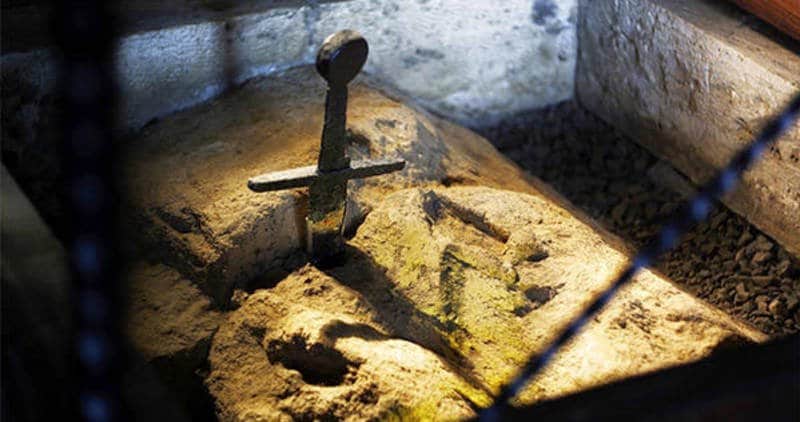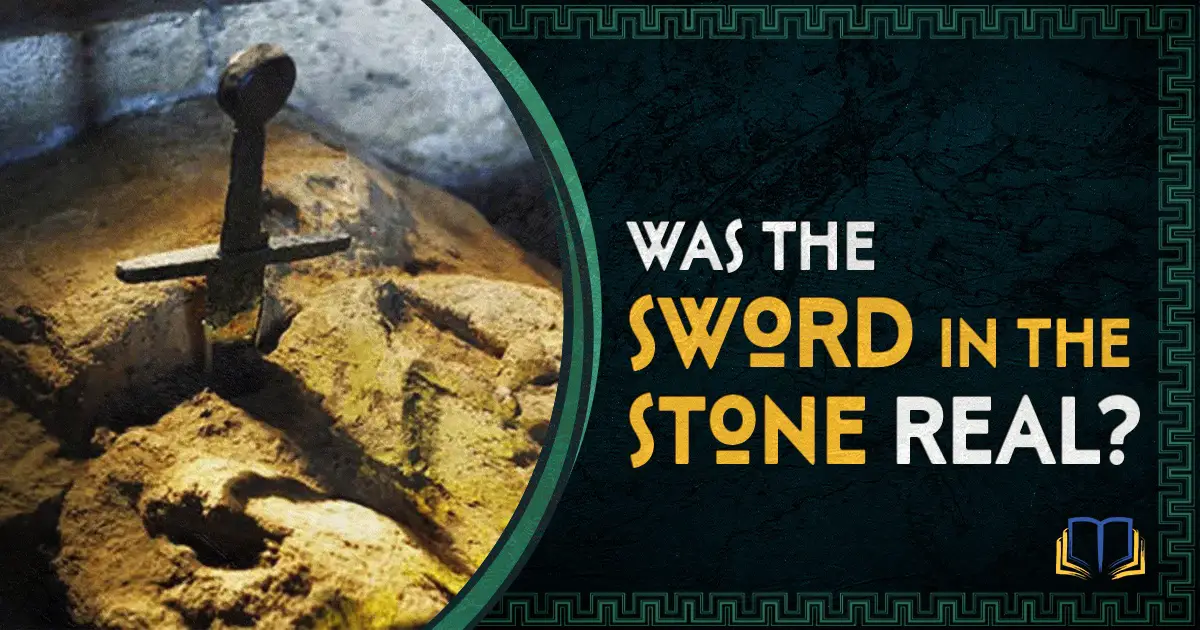One of the most instantly recognizable elements from the Arthurian legends is the Sword in the Stone. It has appeared in countless forms of media, and is popularly considered a fundamental part of the story of King Arthur. After all, it is what led to Arthur becoming king in the first place, so without it, none of the rest of his life story could have happened.
But given that it is apparently so fundamental to Arthurian lore, we do well to ask whether there was any historical basis to it at all, or whether it was just the invention of a medieval writer. First of all, let us familiarize ourselves with what exactly it was supposed to have been, according to the legends.
The Story
The Sword in the Stone was located in the churchyard of St Paul’s Cathedral in London. It had an inscription on it which stated that it could only be removed from its place (piercing an anvil which was atop a stone) by the rightful king of Britain.
One day, Arthur’s foster brother, Kay, was about to engage in a contest when he realized that he had forgotten his sword. He told Arthur to fetch one for him, but on the way, Arthur saw the Sword in the Stone. Not realizing its significance, he withdrew it from its place and brought it to Kay. His older brother recognized it at once, and this then eventually led to everyone accepting Arthur as the rightful king of Britain.
That is the story, but is there any truth to it? Of course, if there is any truth behind it, it would have to be quite far removed from the way the existing story presents things. A sword which can only be withdrawn by a person of specific lineage is transparently impossible.
This fact – that if there is any truth to the legend, it would have to be very different to the actual story – has fueled all sorts of different ideas, with varying similarities to the concept in the legend. Let us take a look at some of these theories.
An Irish Ceremony
One theory, which is really founded on the idea that the Irish prince Artuir mac Aedan was the historical King Arthur, is that the story comes from an accession ceremony performed by the Irish royalty of Dal Riada in Scotland. This ceremony involved the use of a stone known as the Stone of Scone, or the Stone of Destiny. According to one tradition, this stone was brought from Ireland to Scotland by Fergus mac Erc about the turn of the sixth century.
This stone was used in the accession ceremony of the Irish kings in Scotland, until eventually it was captured by the English in the 13th century. Since that time, it has been used by the English monarchs in their accession ceremonies, even up until modern times. It is therefore of considerable national significance.
However, most pertinent for our current investigation is the question of how exactly the stone was used. There are legendary accounts of a stone called the Lia Fáil, which was used in accession ceremonies in Ireland itself, and this stone may or may not have been the same as the Stone of Scone. The Lia Fáil was said to have served as an indicator of the rightful new king, inasmuch as the prospective king would leap over the stone, and if acknowledged by the stone as legitimate, it would ‘roar with joy’. Whether this legendary account actually applied to the Stone of Scone is unclear.
In any case, while in Scotland, it appears that the Stone of Scone did not involve a ceremony quite like the one just described, but it was similar. The new king would kneel or step onto the stone, and if legitimate, the stone would emit a shriek. After the stone was stolen by the English, the ceremony had evolved so that the new king would simply sit on the stone.
While we cannot be sure what stage of the development of this accession ceremony we should be considering, the most likely form that it took in the time of Artuir mac Aedan is the middle one. He would have knelt or stepped onto the stone to be recognized as the true king.
This does have some similarities to the Arthurian story. There is a stone, and this stone is in some way connected with revealing whether a particular claimant is the rightful king or not. Furthermore, at least one source for the Stone of Scone describes it as marble, which matches the description found in the earliest account of Arthur’s Sword in the Stone. However, the similarities end there. A sword was not involved in the Irish accession test. And beyond this, Artuir mac Aedan was never king, so he would never have performed this ceremony. So while this is vaguely similar to the legend, let us continue our search.
A London Tradition

An alternative theory is one which is more compatible with the details of the Arthurian legend in a few ways. This theory is that the story comes from accounts of Arthur striking the London Stone in London with his sword upon becoming, or declaring himself, king.
This is a more appealing explanation than the previous theory on the grounds that it actually involves a sword. And not only does it involve a sword as well as a stone, but it also involves physical contact between the two. Also, it would have taken place in London, just as this Arthurian story is set in London. So we can already see some reasons to believe this over the Irish theory. However, what evidence is there that Arthur would have actually done this?
The supposed evidence for this idea comes from the actions of a certain Jack Cade, the leader of a rebellion against King Henry VI in 1450. His rebellion started in Kent and moved through the country before arriving at London. Once there, Cade struck the London Stone with his sword and declared himself lord of the city.
According to some sources, this was a traditional custom for the mayors of the city. The London Stone apparently has groves on the top, which have been interpreted by some as evidence for repeated sword strikes. This would lend credence to the idea that Jack Cade’s actions were following a traditional custom.
So, could it be that the story of the Sword in the Stone was merely a garbled account of Arthur striking the London Stone with his sword to declare himself the new king? Well, it is certainly a more plausible explanation than the Irish ceremony already considered, at least in terms of the physical actions involved. Additionally, the location of the stone is London, which matches the Arthurian story.
However, there are problems. Unlike the Irish ceremony, there is no genuine evidence that this custom existed in the time of Arthur. Furthermore, even though the legends do claim that it took place in London, should we really believe this? The majority of the early evidence places Arthur either in Wales, in the north of England or southern Scotland, or in Dumnonia. There is no good evidence that Arthur was ever in London, which only starts being associated with the legendary king in the later romance tales. After all, there is no evidence that London was still a major settlement in Arthur’s time. The Roman city was likely abandoned by the latter half of the fifth century, and it is likely that Anglo-Saxons had already started to settle that area by the time Arthur was born.
So in reality, it is quite unlikely that this London Stone had anything to do with the Arthurian story of the Sword in the Stone. If there is any true origin to the story, then it appears that we must look to another explanation.
Religious Symbolism
A theory which has much more evidence for it than the previous one is the idea that the Sword in the Stone is an example of religious symbolism in the Arthurian legends. After all, the stone is placed in a churchyard right from its earliest appearance, pointing towards a religious connection.
As to just what exactly the symbolism might be, the words of King Edgar of the 10th century provide us with a clue. He said to the clergy that he had the sword of Constantine, while they had the sword of Peter. This terminology was based on the fact that Peter was believed to have been the first of the line of popes, having been given supremacy over the other apostles of Jesus according to Catholic belief. Furthermore, a ‘sword’ is often used to represent authority, so altogether, the expression ‘the sword of Peter’ denotes supreme religious authority.
In the earliest accounts of Arthur, such as the Historia Brittonum and the Welsh Annals, Arthur is shown to have possessed a significant religious role. He is described as ‘carrying the Cross upon his shoulders’ in one source and ‘the image of Mary’ in the other source. Perhaps this religious role was intricately connected to his position as king in this era, just as the Roman Emperors up until the late-fourth century had the role of ‘Pontifex Maximus’ – a title now held by the Catholic pope.
On this basis, it has been argued by some that Arthur could have been described as having ‘the sword of Peter’, due to his religious role. And if this was something that was intricately connected to the position of king in this era, then it could be said that the sword of Peter could only be possessed by the rightful king.
The reason this is potentially significant lies in the meaning of the name ‘Peter’. It means ‘rock’, or ‘stone’. Therefore, it has been suggested that the expression ‘the sword of Peter’ could have been mistranslated as ‘the sword of the stone’, which then progressively developed into the story of the sword in the stone as we now know it.
Alternatively, it could be that there was no mistranslation, but it was an intentional piece of symbolism. Due to a passage in the Bible in Matthew chapter 16, the meaning of Peter’s name was very well known among Christians. It was widely believed that he was the ‘rock’ upon which Jesus would build the Christian congregation. Therefore, it is entirely plausible that medieval Christian writers would have used a rock in their stories to symbolize Peter. If so, then we could see why they may have chosen to portray the ‘authority of Peter’ as a sword stuck within a stone.
One criticism of this idea is the fact that the sword is, in the original account as found in Robert de Boron’s Merlin, described as being embedded through an anvil on top of a stone, rather than directly sticking into the stone itself. Nonetheless, as Robert first describes the sword, stone, and anvil, the account definitely states that the sword was ‘fixed into the stone’, albeit going through the anvil.
Also important is the statement that was said to have been written on the side of the sword. This might reflect the original statement or expression around which the whole fanciful story was later built. Robert describes the sword as having the words: “Who takes this sword out of this stone should be king by the election of Jesus Christ.”So the sword is definitely described as being stuck in the stone, rather than the anvil. Later, after Arthur brings it to his foster brother Kay, it is repeatedly referred to as ‘the sword of the stone’. The anvil is clearly incidental to the story.
The fact that the sword could only be removed by the rightful king would be explained by this theory if the kingship in Arthur’s era involved a particular religious role, as is supported by the Historia Brittonum and the Welsh Annals, according to supporters of this theory. Furthermore, the fact that Robert’s account states that the sword itself claimed that the one who took it from the stone should be made king ‘by the election of Jesus Christ’ clearly shows that there was religious significance to the procedure. In fact, throughout the account there is a clear religious element, such as the fact that the archbishop told Arthur: “fetch the sword with which you shall keep justice, to defend the Holy Church, and maintain right and the Christian faith to your power.” Other statements are made to similar effect.
As part of Arthur’s accession ceremony, he laid the sword upon the altar of the church in whose grounds the stone was situated. So, once more, we see a firm religious connection to the sword and Arthur’s whole accession procedure. This is strong evidence that the sword represented religious authority, as this theory supposes. Perhaps, then, Robert’s ‘sword of the stone’ really was the figurative ‘sword of Peter’.
The Problem of Provenance

One issue with all of these explanations is the fact that the story of the Sword in the Stone is not mentioned until about the turn of the 13th century. The earliest Arthurian account was written in the ninth century, and it is possible that a surviving reference to Arthur even exists from the turn of the seventh century. In view of this, the fact that this element of Arthurian lore was not mentioned until the 13th century could be taken as strong evidence against its authenticity. The thinking goes that if it genuinely had its roots in the Dark Ages, it would surely have been mentioned far earlier in the surviving corpus of Arthurian material.
While this argument does have a logic to it, it is important to take a more nuanced examination of the evidence. While the earliest account of Arthur is found in Nennius’s description of his battles in the ninth century Historia Brittonum, this does not give any information about his accession to the throne. The Lives of the Saints also do not give any information of this sort, but they merely convey certain episodes in Arthur’s life.
In reality, the earliest description of Arthur’s accession to the throne is found in Geoffrey of Monmouth’s Historia Regum Britanniae, written less than 100 years before Robert de Boron wrote his Merlin. In fact, the two works were possibly separated by just some 60 years. While there were quite a number of Arthurian tales written within this period, the vast majority do not touch on the beginning of Arthur’s reign. In fact, one of the only accounts that does is Roman de Brut by Wace in c. 1155.
So even though there are a multitude of Arthurian sources that were written prior to Robert de Boron’s Merlin, this is deceptive. In reality, the account of the Sword in the Stone appears in one of the earliest accounts of Arthur’s accession to the throne. This means that its authenticity need not be questioned too much.
Of course, it cannot be the case that this story goes right back to the time of Arthur. If the ‘religious symbolism’ theory is correct, then the story as it appears in Robert de Boron’s Merlin is an extensive elaboration based on some kind of statement or expression to the effect that only the one who was the true heir to the throne would, or could, possess the sword (or authority) of Peter. This expression could well go back to the time of Arthur. But the story based on that expression is clearly a later development, and would not necessarily greatly predate the time of Robert de Boron.
Conclusion
In summary, we can see that there are a few theories which have been proposed as explanations for Arthur’s legendary Sword in the Stone. One is based on the theory that Arthur was actually the Irish prince Artuir mac Aedan, and the stone was the Stone of Scone. This theory falls down on the basis of a lack of similarity between the Arthurian story and the historical ceremony involving the use of the Stone of Scone. Furthermore, Artuir was never king, so he could never have performed this ceremony.
The second theory involves the London Stone, but this is severely undermined by the fact that there is no evidence that Jack Cade’s actions reflected a traditional ceremony going back to the time of Arthur. In addition, it is very unlikely that Arthur would have been active in London.
The third theory is that the ‘Sword of the Stone’ was actually the ‘sword of Peter’, a symbol for the religious authority that only the rightful king could possess. This is supported by the fact that throughout the earliest account of this story, there is a very strong religious component to the proceedings. Furthermore, the expression upon which this story would have been based could plausibly have been used in Arthur’s own time, since it is known that the kings of Britain at the time really did view themselves as Christian.
Therefore, if Robert de Boron’s account does have any basis in genuine tradition, this third theory is the most likely explanation.
Arthurian Bibliography
- Norris Lacy, Geoffrey Ashe, Debra Mancoff – The Arthurian Handbook (Second Edition)
- Alan Lupack – The Oxford Guide to Arthurian Literature and Legend
- Ronan Coghlan – The Illustrated Encyclopaedia of Arthurian Legends
- Anonymous – Lancelot-Grail, the French Vulgate
- Sir Thomas Malory – Le Morte d’Arthur
See also my ever-expanding list of primary and secondary sources.




Very interesting tho tintagel in Wales may have the grail and it’s said that the Tor was a island with a seaport tho the wicker church was built in it’s origin by Joseph Jesus’s father whom was a trader in cloth and had his own ship
In light of the development of psychological approaches to the understanding of legends your study and commentary are very interesting and helpful to me. It is telling that these people felt and experienced the literal mystery of the cosmos “in each other” and they respected it – that’s why there is so much awe around and respect for personages who manifest the divine! Psychologists would just call this projection….whereas perceiving this legend as a mythological tale renders a deeper reading, full of symbolism. I did not make the connection to the church of Saint Peter (petros- Greek – “stone”) and the sword in the stone which was very interesting. Political and religious power are seen to be coming together but it’s not the kind of power that the ego wants to see… You did not mention that the sword in the stone appeared on Christmas Eve (as I understand it) which would also be a reference to the divinity connection between Jesus and Arthur. I am wrestling with the story on a different level and I’m currently writing a book to reflect how this story represents the birth of democracy and also the matriculation of eastern metaphysical thinking into the west. Let me know if you want to know more! Thank you for your work here!!